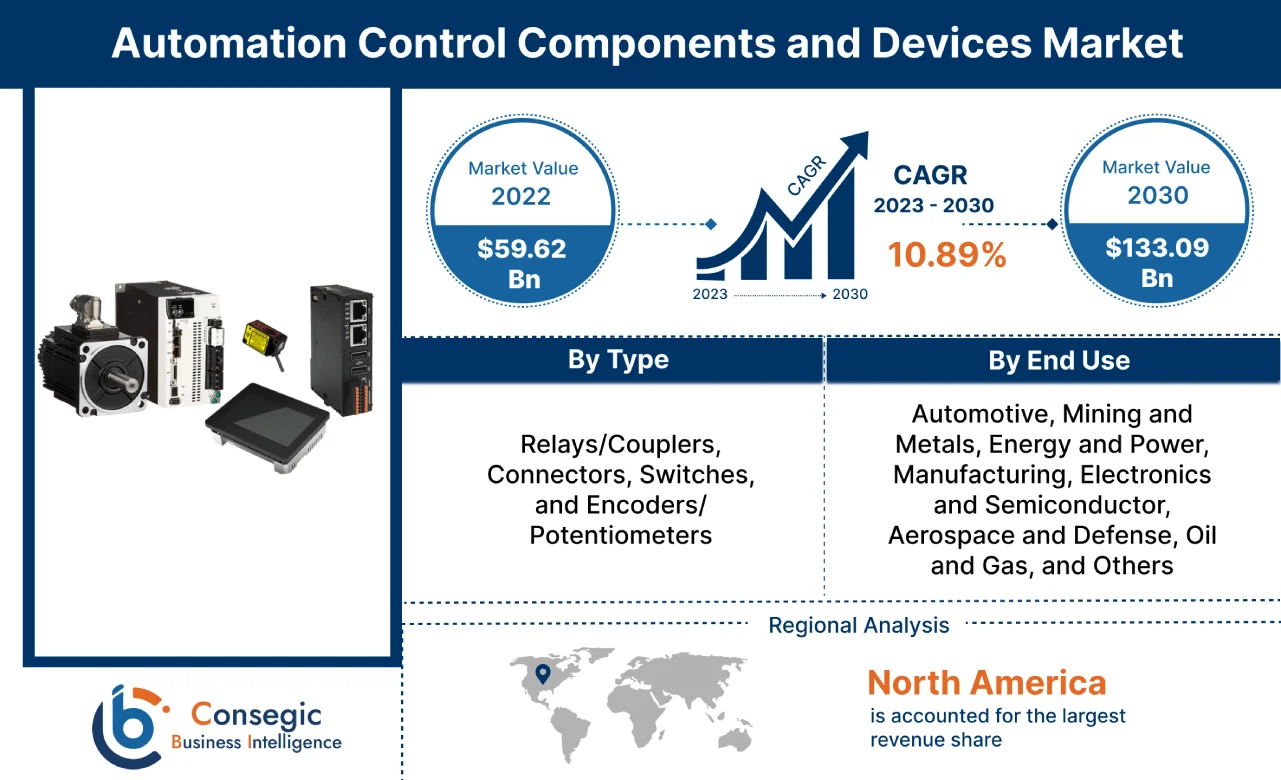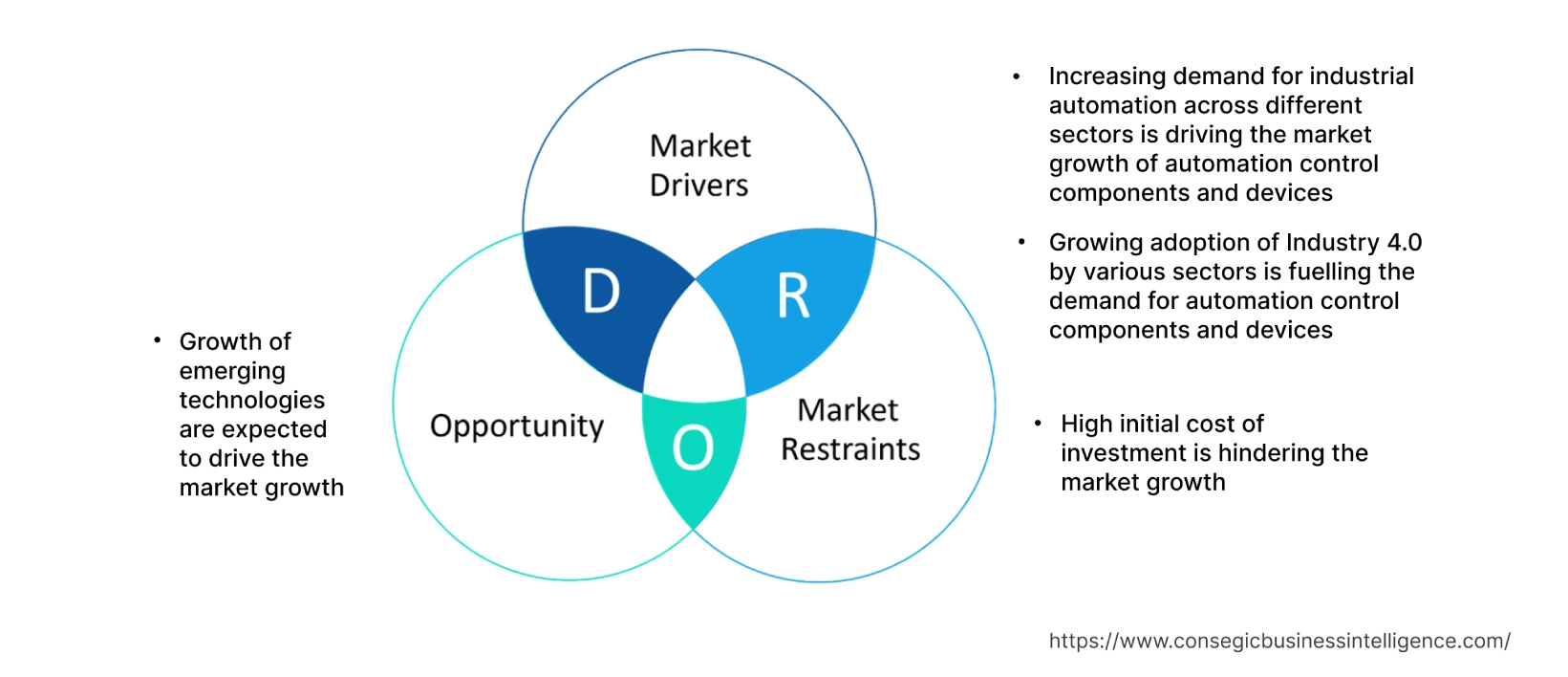- Summary
- Table Of Content
- Methodology
Automation Control Components and Devices Market Introduction :
Automation Control Components and Devices Market is estimated to reach over USD 133.09 Billion by 2030 from a value of USD 59.62 Billion in 2022, growing at a CAGR of 10.89% from 2023 to 2030.
Automation Control Components and Devices Market Definition & Overview:
Automation control components include different devices, systems, and processes that collectively allow to automate the machines. In another terms, automation control components and devices are associated with automation by means of use of machines, information technologies, and control systems to optimize productivity in the process of manufacturing by minimizing the involvement of human. Moreover, automation control components and devices allow plants operators in a more efficient and optimized manner by utilizing various control systems including Human-machine Interface (HMIs), Programmable Logic Circuit (PLC), and robotics. Furthermore, in addition to aforementioned control systems, there has always been requirement for various types of equipment including switches, pressure sensors, temperature sensors, and others.
Automation Control Components and Devices Market Insights :
Key Drivers :
Increasing demand for industrial automation across different sectors is driving the market growth of automation control components and devices
Automation control components and devices are essential for attaining high quality production and flexibility in the manufacturing processes. The key objective of automation control components and devices is to provide assistance to machines in order to automate the production process and increase productivity. Thus, automation allows to reduce the cost of production by minimal human intervention. Automation thus also reduces the chances of error that tends to generate during human involvement. Industry including automotive has been promoting industrial automation since longer duration. In addition, the automotive production line is installed with robots that help in installing pistons into the engine. Accordingly, the error rate has now drastically reduced from 1-1.5% to 0.00001% upon installation of robots.
The key factors contributing towards the growth of automation control components and devices include high productivity, high quality, high flexibility, high information accuracy, and high safety. Moreover, with the rising demand for process automation by manufacturing industries and implementing of automated production line has been boosting the demand for automation control components and devices market. According to International Federation of Robotics, automotive industry is the foremost user of industrial robots with 50% of them utilized by this sector. Therefore, the demand for automation control switches, relays, encoders and similar other devices is pushing the market growth for automation control components and devices.
Growing adoption of Industry 4.0 by various sectors is fuelling the demand for automation control components and devices
Industry 4.0 revolution is presently being implemented in different industries mainly utilizing information and communication technologies. Production systems utilizing computing technologies include network link and internet connection require smart devices and hardware for functioning of manufacturing plants. Moreover, devices including relays/couplers, connectors, switches, and others are largely employed in the functioning of industry 4.0 trends. Moreover, technologies including digital manufacturing, computer technology, communication technology, and automation technologies are included in industry 4.0 which is bolstering the demand for automation control components and devices.
Devices are playing an important role in fulfilling the requirements of industry 4.0 standards. For instance, NI USB-6211 bus-powered M series Multifunction DAQ device launched by National Instruments Corporation offers analog I/O, two 32 bit counters, digital output, and digital input. Accordingly, different components and devices utilized in industrial production are promoting the market trends for industry 4.0, ultimately driving the market growth of automation control components and devices.
Key Restraints :
High initial cost of investment is hindering the market growth
Automation control components and devices market growth is limited by high cost of investment owing to implementation of several different components. The automation cost is variable in nature and varies depending on the industry. Factors restraining the growth include employee cost, equipment cost, technology, software, hardware cost, among others. Moreover, equipment cost including setting up of numerous numbers of devices, connectors, encoders, and others tends to be high depending on the area of installation. Furthermore, costing including maintenance and hiring of skilled employee for proper functioning of devices and instruments tends to be high, which is ultimately restraining the market growth.
Future Opportunities :
Growth of emerging technologies are expected to drive the market growth
Industry 4.0 is mainly focused on the implementation of internet based technologies that include Internet of Things (IoT) and Industrial Internet of Things. Moreover, with the implementation of 5G networks, edge computing, and advanced materials tend to boost the market growth of automation control components and devices. Internet connectivity plays an important role in connecting devices and allows them to function at faster rate. Sectors including healthcare, automotive, education, among others are increasingly relying on proper network connectivity which is ultimately going to boost the demand for 5G networks, thus ultimately driving the market growth of automation control components and devices during the forecast period.
Automation Control Components and Devices Market Report Insights :
| Report Attributes | Report Details |
| Study Timeline | 2017-2030 |
| Market Size in 2030 | USD 133.09 Billion |
| CAGR (2023-2030) | 10.89% |
| By Type | Relays/Couplers, Connectors, Switches, and Encoders/Potentiometers |
| By End Use | Automotive, Mining and Metals, Energy and Power, Manufacturing, Electronics and Semiconductor, Aerospace and Defense, Oil and Gas, and Others |
| By Region | North America, Europe, Asia-Pacific, Latin America, and Middle East & Africa |
| Key Players | Delta Electronics, Inc., Rockwell Automation, Inc., Emerson Electric Co., ABB Limited, Panasonic Corporation, Control Components, OMRON Corporation, Baumer Limited, Schneider Electric, Encoder Products Company, PHOENIX, AMETEK, Inc., LUTZE Inc., General Electric, Teledyne Technologies Incorporated, MKS Instruments, Honeywell International Inc., Siemens, Mitsubishi Electric Corporation |
Automation Control Components and Devices Market Segmental Analysis :
Based on the Type :
Based on the type, the market is divided into relays/couplers, connectors, switches, and encoders/potentiometers. The switches segment is accounted for the largest revenue share of 38.6% in the year 2022. Switches are extensively used in factory automation and industrial settings for their requirements in controlling the flow of electricity or signals within automated systems. In addition, their demand remains to be constant in the industrial installations owing to on/off or control functions. For instance, Limit Switch is employed for control and monitoring of automated machinery and other industrial equipment. Eaton, a manufacturer of limit switches offers various models including E49 mini metal limit switches, E49 compact metal limit switches, E47 precision limit switches, and others.
Moreover, encoders segment is projected to grow at the fastest growth rate during the forecast period. The key factors attributed to the growth of the segment is due to increasing pace of automation and requirement for collecting of reliable and specific data including rotation, speed, position of machines in automated systems. The demand for encoders is mainly required by the sectors that rely on precise motion control including manufacturing, CNC machinery, and among others. For instance, Red Lion Controls Inc. is offering ZCG series of encoders mainly known as general duty shaft encoders.
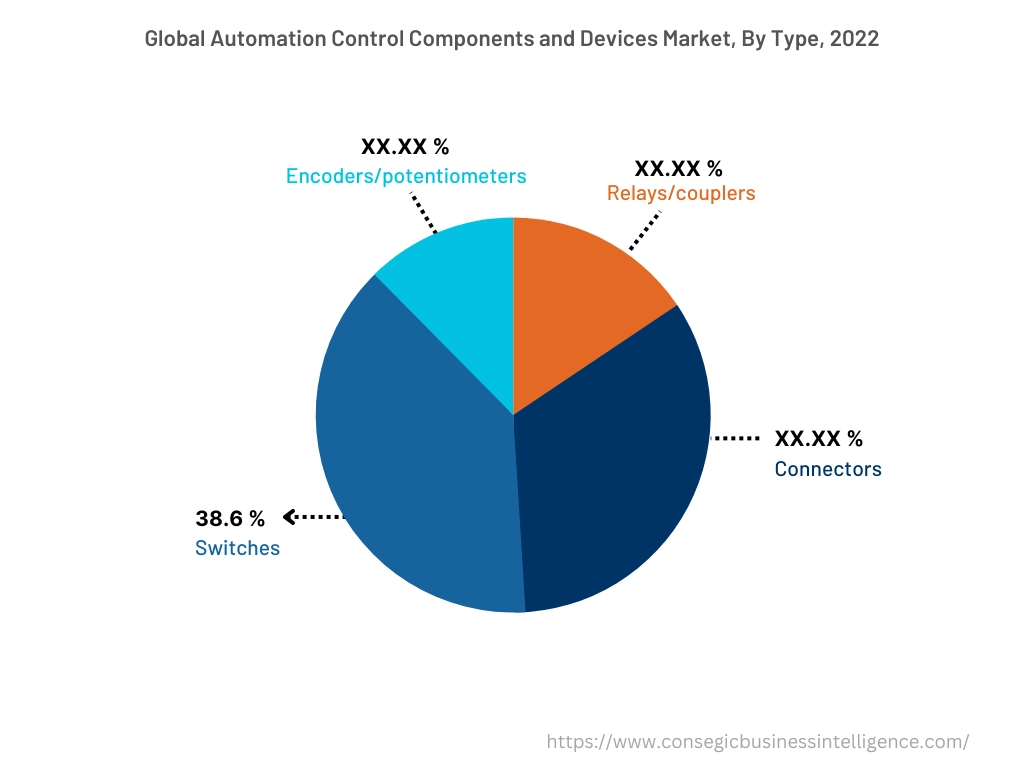
Based on the End-Use :
Based on the end use, the market is segmented into automotive, mining and metals, energy and power, manufacturing, electronics and semiconductor, aerospace and defense, oil and gas, and others. Manufacturing segment is accounted to generate largest market share in the year 2022. The key factors attributed to the growth of the segment include increasing trend of industry 4.0 and growing inclination of manufacturers towards process automation. Moreover, the growing interest of businesses in optimizing production capacity and garnering maximum benefit from production is driving the market growth of automation control components and devices in the manufacturing sector. For instance, connectors are utilized to establish secure connection for electrical and data transfer. Connectors are mainly employed for applications including wiring harness, PCB assemblies, industrial machinery, among others.
Moreover, automotive segment is projected to grow at the fastest growth rate during the forecast period. Owing to rising demand for electric and hybrid vehicles to curb environmental pollution is promoting the demand for switches, encoders, connectors, and others. For instance, relays/couplers are used to control electrical signals and provide isolation between different parts of the systems thus providing a convenient flow of connectivity between the devices. Furthermore, according to International Energy Agency, the sales of electric vehicles is estimated to reach 14 million by the end of the year 2023. Therefore, owing to the rising demand for electric vehicles in near future, the market growth for automation control components and devices is expected to flourish during the forecast period.
Based on the Region :
The regional segment includes North America, Europe, Asia Pacific, Middle East and Africa, and Latin America.
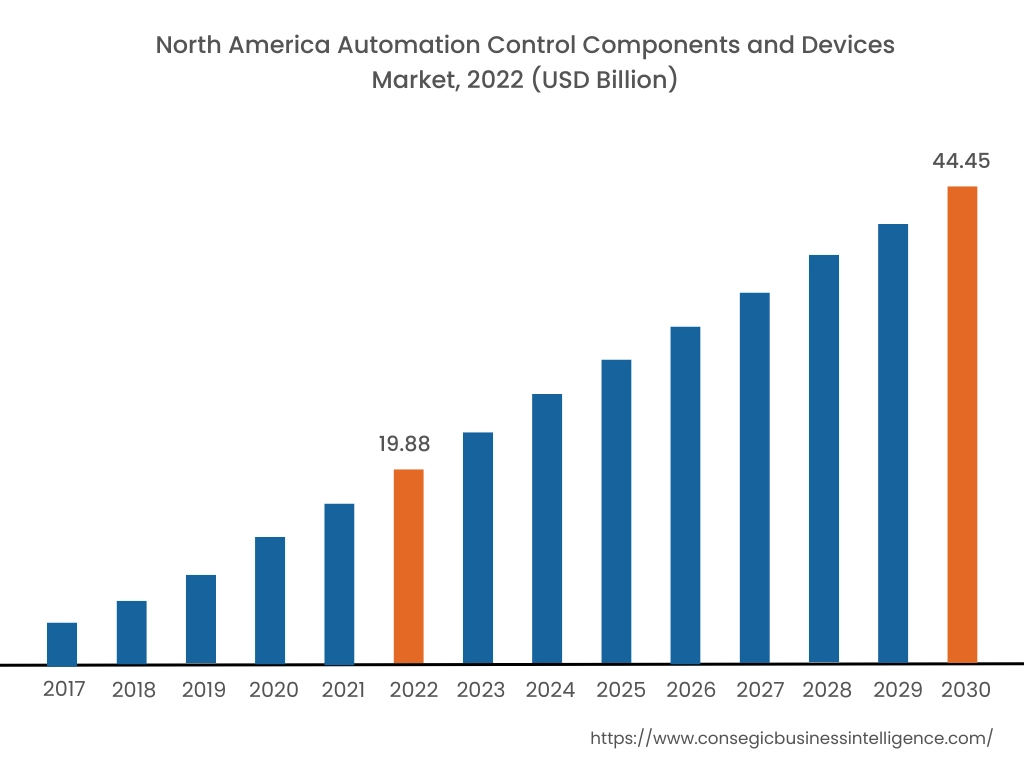
North America is accounted for the largest revenue share of USD 19.88 Billion in 2022 and is expected to reach USD 44.45 Billion by 2030. In addition, in the region, the U.S. accounted for the maximum revenue share of 61.5% in the same year. The adoption of automation control components and devices in North American region is primarily driven by factors including growth in advanced manufacturing, technological advancement, regulatory and safety compliance.
North America has a strong and diverse manufacturing sector which relies on automation. In order to improve efficiency, reduce cost of production and maintain high quality of production, the region has adopted the technologies including automation, IIoT (Industrial Internet of Things), 5G network, and others.
Moreover, Asia-Pacific is expected to register fastest CAGR growth of 11.2% during the forecast period. Factor attributable to the growth of the region during the forecast period is due to increasing global expansion of developing nations present within the region. Countries including China and India are exponentially improving the production capacity by improving and applying innovative methods. Among which industrial automation is playing a major role in fulfilling the growing requirements of industrial goods. Furthermore, advent of emerging technologies including robotics artificial intelligence, machine learning, and automation will proliferate the development of the region along with rise in demand for automation control components and devices.
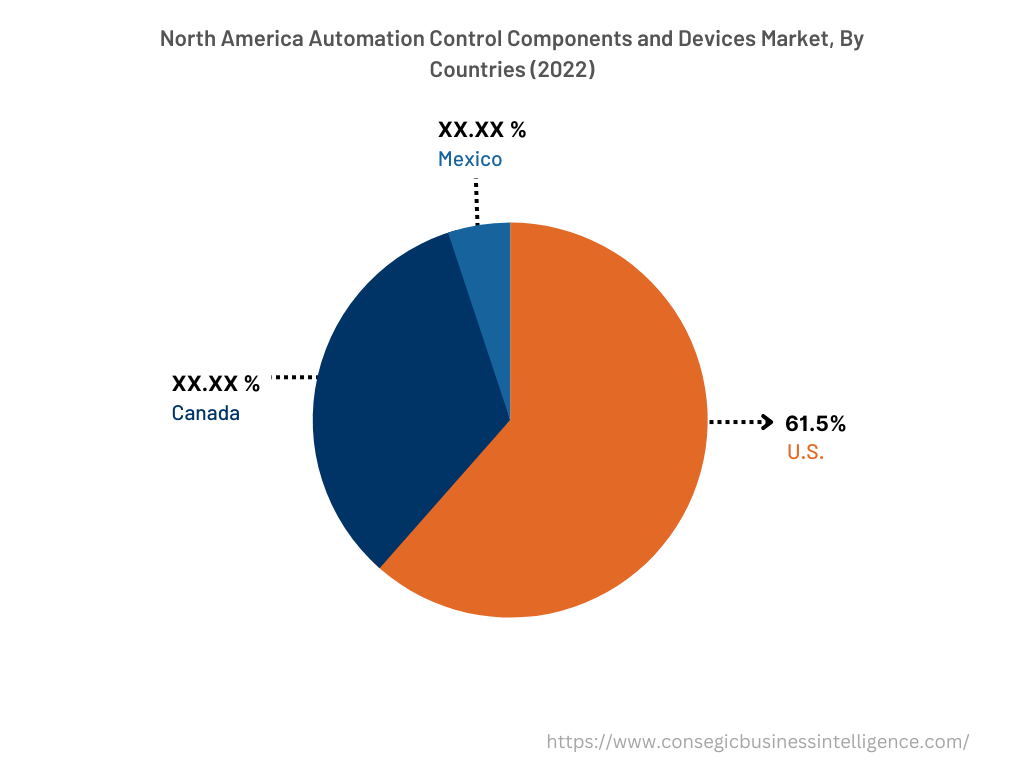
Top Key Players & Market Share Insights:
The Automation Control Components and Devices market is highly competitive with major players providing Automation Control Components and Devices to the national and international markets. Key players are adopting several strategies in research and development (R&D), product innovation, and end use launches to hold a strong position in Automation Control Components and Devices market. Key players in the Automation Control Components and Devices market include-
- Delta Electronics, Inc.
- Rockwell Automation, Inc.
- LUTZE Inc.
- General Electric
- Teledyne Technologies Incorporated
- MKS Instruments
- Honeywell International Inc.
- Siemens
- Mitsubishi Electric Corporation
- Emerson Electric Co.
- ABB Limited
- Panasonic Corporation
- Control Components
- OMRON Corporation
- Baumer Limited
- Schneider Electric
- Encoder Products Company
- PHOENIX
- AMETEK, Inc.
Recent Industry Developments :
- In September 2022, ISOCOM Limited launched latching solid state relays that are capable of switching a large number of currents up to 60Amps coupled with additional memory thus remembering its last position until new current is introduced.
- In May 2021, Toshiba launched TLP3910, a photovoltaic output photocoupler for isolated solid state relays.
Key Questions Answered in the Report
What is Automation Control Components and Devices? +
Automation control components include different devices, systems, and processes that collectively allow to automate the machines.
What specific segmentation details are covered in the automation control components and devices report, and how is the dominating segment impacting the market growth? +
For instance, by type segment has witnessed switches as the dominating segment in the year 2022, owing to its increasing demand from industries including aerospace, automotive, and others.
What specific segmentation details are covered in the automation control components and devices market report, and how is the fastest segment anticipated to impact the market growth? +
For instance, by end use segment has witnessed automotive segment to grow at the fastest growth rate during the forecast period. The rising demand for electric vehicles across the globe has been pushing the production line for each manufacturer to manufacture large volume of vehicles.
Which region/country is anticipated to witness the highest CAGR during the forecast period, 2023-2030? +
Asia-Pacific is anticipated to register fastest CAGR growth of 11.2% during the forecast period due to rapid pace of industrialization and growth of multiple industries including industrial automation, healthcare, and others.
